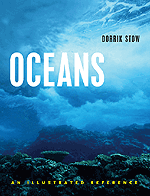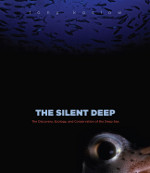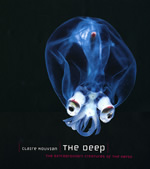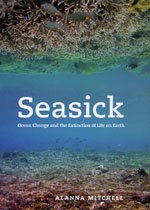Happy (Belated) World Oceans Day!
Monday, June 8, was the inaugural observance of the United Nations’ World Oceans Day. UN Secretary-General Ban Ki-moon said about the celebration, “The first observance of World Oceans Day allows us to highlight the many ways in which oceans contribute to society. It is also an opportunity to recognize the considerable challenges we face in maintaining their capacity to regulate the global climate, supply essential ecosystem services and provide sustainable livelihoods and safe recreation.”
It’s hard to believe, but for thousands of years, the world’s oceans were considered unimportant—at most a means of global travel and a source of food, at least a dumping ground for trash. We now know that the ecosystem that makes up 99 percent of living space on Earth is our life-support system, regulating the planet’s temperatures, climate, and key chemical cycles. With this global commemoration of our planet’s most fragile ecosystem, the world oceans are at last getting the attention they need and deserve.
The University of Chicago Press has long recognized the important role our oceans play in our planet’s health. In honor of World Oceans Day, we present this maritime reading list.
 Four billion years old, the oceans formed as the Earth’s scorching surface cooled, the primordial atmosphere condensed, and torrential rains fell. Their color is the unique signature of our blue planet, their composition a chemical cocktail of remarkable variety, their waters a theater of constant change. Oceans: An Illustrated Reference tells the story of this last great frontier. With hundreds of beautiful full-color photographs and explanatory diagrams, charts, and maps, Oceans combines the visual splendor of ocean life with up-to-date scientific information to provide an invaluable and fascinating resource on this vital realm. Although the oceans are vast, their resources are finite. Oceans clearly presents the future challenge to us all–that of ensuring that our common ocean heritage is duly respected, wisely managed, and carefully harnessed for the benefit of the whole planet.
Four billion years old, the oceans formed as the Earth’s scorching surface cooled, the primordial atmosphere condensed, and torrential rains fell. Their color is the unique signature of our blue planet, their composition a chemical cocktail of remarkable variety, their waters a theater of constant change. Oceans: An Illustrated Reference tells the story of this last great frontier. With hundreds of beautiful full-color photographs and explanatory diagrams, charts, and maps, Oceans combines the visual splendor of ocean life with up-to-date scientific information to provide an invaluable and fascinating resource on this vital realm. Although the oceans are vast, their resources are finite. Oceans clearly presents the future challenge to us all–that of ensuring that our common ocean heritage is duly respected, wisely managed, and carefully harnessed for the benefit of the whole planet.
 The deep sea, closed until recently to exploration, was long dismissed as lifeless and uninteresting. Only in the last fifty years or so did the deep sea—with its Lilliputian fauna on the seafloor; its seemingly bizarre life forms at mid-ocean depths; its profusion of life at hot vents, cold seeps, and whale falls; and its coldwater corals and fisheries on seamounts and deepwater reefs—reveal itself to be a source of scientific wonderment and, indeed, the planet’s last unexplored frontier. But just as research and exploration are rendering the briny deep accessible, a host of new threats is endangering it—the spread of trawling into the deep ocean, the buildup of humanity’s worst pollutants in deepwater life-forms, the potential consequences of climate change and ocean acidification, and the future mining of seabed minerals and methane hydrates for hydrocarbons. The Silent Deep tells the stories of discovery of the deep sea, the ecologies of its ecosystems, and of the impact of humans, highlighting the importance of global stewardship in keeping this delicate ecosystem alive and well. Written by world renowned deep-sea ecologist Tony Koslow, The Silent Deep is a comprehensive and authoritative overview of the state of the deep sea today, accessible to anyone interested in ocean science, the story of scientific discovery, and conservation of the earth’s most threatened ecosystems.
The deep sea, closed until recently to exploration, was long dismissed as lifeless and uninteresting. Only in the last fifty years or so did the deep sea—with its Lilliputian fauna on the seafloor; its seemingly bizarre life forms at mid-ocean depths; its profusion of life at hot vents, cold seeps, and whale falls; and its coldwater corals and fisheries on seamounts and deepwater reefs—reveal itself to be a source of scientific wonderment and, indeed, the planet’s last unexplored frontier. But just as research and exploration are rendering the briny deep accessible, a host of new threats is endangering it—the spread of trawling into the deep ocean, the buildup of humanity’s worst pollutants in deepwater life-forms, the potential consequences of climate change and ocean acidification, and the future mining of seabed minerals and methane hydrates for hydrocarbons. The Silent Deep tells the stories of discovery of the deep sea, the ecologies of its ecosystems, and of the impact of humans, highlighting the importance of global stewardship in keeping this delicate ecosystem alive and well. Written by world renowned deep-sea ecologist Tony Koslow, The Silent Deep is a comprehensive and authoritative overview of the state of the deep sea today, accessible to anyone interested in ocean science, the story of scientific discovery, and conservation of the earth’s most threatened ecosystems.
 If Koslow’s book fails to convince you of the need to protect the diversity of life in the deep sea, take one look at the Dumbo Octopus and you’ll probably have a change of heart. That little guy is just one of the hundreds of bizarre and beautiful creatures featured in this photographic tour of the briny abyss. Combining the latest scientific discoveries with astonishing color imagery, The Deep takes readers on a voyage into the darkest realms of the ocean. Revealing nature’s oddest and most mesmerizing creatures in crystalline detail, The Deep features more than two hundred color photographs of terrifying sea monsters, living fossils, and ethereal bioluminescent creatures, some photographed here for the very first time. Accompanying these breathtaking photographs are contributions from some of the world’s most respected researchers that examine the biology of deep-sea organisms, the ecology of deep-sea habitats, and the history of deep-sea exploration. An unforgettable visual and scientific tour of the teeming abyss, The Deep celebrates the incredible diversity of life on Earth and will captivate anyone intrigued by the unseen—and unimaginable—creatures of the deep sea.
If Koslow’s book fails to convince you of the need to protect the diversity of life in the deep sea, take one look at the Dumbo Octopus and you’ll probably have a change of heart. That little guy is just one of the hundreds of bizarre and beautiful creatures featured in this photographic tour of the briny abyss. Combining the latest scientific discoveries with astonishing color imagery, The Deep takes readers on a voyage into the darkest realms of the ocean. Revealing nature’s oddest and most mesmerizing creatures in crystalline detail, The Deep features more than two hundred color photographs of terrifying sea monsters, living fossils, and ethereal bioluminescent creatures, some photographed here for the very first time. Accompanying these breathtaking photographs are contributions from some of the world’s most respected researchers that examine the biology of deep-sea organisms, the ecology of deep-sea habitats, and the history of deep-sea exploration. An unforgettable visual and scientific tour of the teeming abyss, The Deep celebrates the incredible diversity of life on Earth and will captivate anyone intrigued by the unseen—and unimaginable—creatures of the deep sea.
 This fall, the Press will publish Alanna Mitchell’s Seasick: Ocean Change and the Extinction of Life on Earth, which is already a runaway bestseller in Canada. Here, veteran science journalist Mitchell dives beneath the surface to the sublime depths of sea and science to give readers a sense of how this watery realm can be managed and preserved, and so with it life on earth. Seasick follows scientists working to understand the oceans, and each chapter features a different group of researchers who introduce readers to the importance of ocean currents, the building of coral structures, and the effects of acidification. With Mitchell at the helm, readers are submersed 3000 feet to gather sea sponges that may contribute to cancer care, see firsthand the lava-lamp-like blob of dead zone covering 17000 square kilometers in the Gulf of Mexico, and witness the simultaneous spawning of corals under a full moon in Panama. The first book to look at the planetary environmental crisis through the lens of the global ocean, Seasick takes the reader on an emotional journey across a remarkable landscape and urges conversation and reverence for the fount from which all life on earth sprang.
This fall, the Press will publish Alanna Mitchell’s Seasick: Ocean Change and the Extinction of Life on Earth, which is already a runaway bestseller in Canada. Here, veteran science journalist Mitchell dives beneath the surface to the sublime depths of sea and science to give readers a sense of how this watery realm can be managed and preserved, and so with it life on earth. Seasick follows scientists working to understand the oceans, and each chapter features a different group of researchers who introduce readers to the importance of ocean currents, the building of coral structures, and the effects of acidification. With Mitchell at the helm, readers are submersed 3000 feet to gather sea sponges that may contribute to cancer care, see firsthand the lava-lamp-like blob of dead zone covering 17000 square kilometers in the Gulf of Mexico, and witness the simultaneous spawning of corals under a full moon in Panama. The first book to look at the planetary environmental crisis through the lens of the global ocean, Seasick takes the reader on an emotional journey across a remarkable landscape and urges conversation and reverence for the fount from which all life on earth sprang.
Be sure to check out all our books on the ocean. May your seas always be smooth!